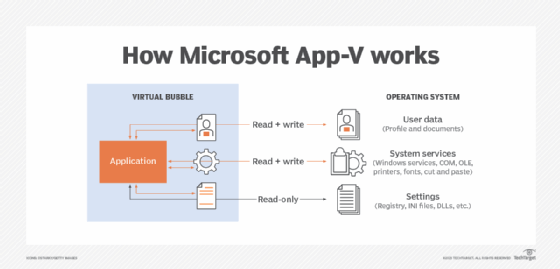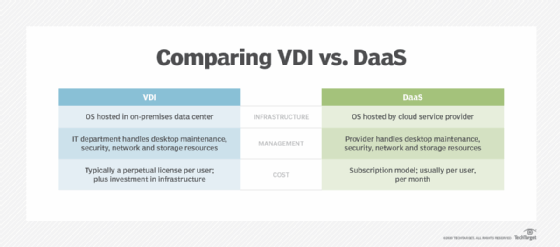Microsoft App-V (Microsoft Application Virtualization)
What is Microsoft App-V?
Microsoft Application Virtualization (App-V) is an application virtualization client that makes an application available to end users without installing it on a personal computer (PC). Instead, Microsoft App-V wraps each application in a virtual layer that sits between the software and the operating system (OS). This lets applications behave as if they're traditionally installed when in fact they're being streamed from a centrally managed service or even from the end user's PC.
Businesses and other organizations use App-V to deploy applications at scale to employees regardless of the location, type or compatibility of the client machines. IT also uses App-V to control user access to applications, ensuring only authorized users have access to certain applications.
App-V was first launched in 2006. It will reach its end of life in April 2026 according to Microsoft. The company recommends users switch to Azure Virtual Desktop with MSIX app attach, which provides a virtual desktop service similar to Windows 365.

How does App-V work?
Microsoft App-V creates a virtual environment, called a bubble, for each application deployed by an organization. This virtual layer is wrapped around the software and isolates it from other applications and the OS. It also includes files, settings and other registry entries required to run the application.
The virtual environment is created on the client machine every time an App-V-enabled application is launched. App-V intercepts and redirects all files and registry requests the application makes to a virtual copy stored in the virtual environment. This lets applications run as if installed locally and enables IT to easily manage and update the virtual environment without affecting a user's personal device.

App-V components
Microsoft App-V includes the following components that are critical to its functioning:
App-V Sequencer. The application virtualization process starts packaging the application into a self-contained environment that runs on the client computer. App-V Sequencer handles this process. It's a wizard-based tool that builds App-V packages, providing all executable components such as sequenced app files, data files, Windows installer files, registry settings and an array of extensible markup language files.
App-V Desktop Client. The Microsoft App-V Desktop Client executes the applications. It resides on the end user's device, and it retrieves and publishes the virtual applications. It also tracks and saves file alterations and custom settings of the published applications.
App-V Management Server. This server centrally delivers and manages applications that the App-V Desktop Client and the Remote Desktop Services Client use. It tracks users and their application in real time through Active Directory, and authenticates application requests to secure and control access to these apps.
The server uses monitoring and metering to track data use. It allows IT to assign application permissions and deliver or remove virtualized applications through a management console. A lightweight version of the App-V server, called the System Center App-V Streaming Server, is also available.
App-V Reporting Server. This App-V server creates and stores reports that show how end users use their virtual applications and application packages.
Benefits of App-V
Microsoft App-V provides IT groups with a lot of time-saving features and flexibility. The following are some of the benefits to using App-V's virtualization software:
- Application compatibility and functionality are improved, enabling older applications to run on modern OSes.
- There is less application conflict and improved user experience.
- Software is easier to deliver and uninstall.
- Less PC support is required when applications run without making changes to the host computer.
- Managing and troubleshooting applications is easier with centralized control.
- Hardware costs might be lower, because App-V lets users run applications without specific hardware requirements.
- Client machines have fewer attack surfaces because installed applications run isolated from the OS and other applications.
- Zero configuration eliminates a key cause of crashes or "hangs" known as Windows' blue screen of death.
Top commercial applications for App-V
App-V can virtualize most enterprise applications. Some common commercial applications it's used with include the following:
- Browsers such as Google Chrome and Microsoft Edge.
- Office integrations such as Microsoft Office 365.
- Email applications such as Microsoft Outlook.
- Multimedia software such as Adobe products.
A small number of applications from third-party providers support the use and management of App-V, including the following:
Advanced Installer is a Windows software installation and packaging tool that supports virtual apps. It provides support for App-V and VMware ThinApp, and lets users create packages of virtual applications.
Cloudpager is Numecent's cloud container program that runs App-V virtual apps; it will do so even after App-V's end of life, according to Numecent.
End of life in 2026
Microsoft has said App-V's end of life will be in April 2026. It hasn't made significant updates to the program in several years. Instead, Microsoft is focusing on their Azure Virtual Desktop program and MSIX container, and it suggests App-V users switch to these programs by 2026.
Azure Virtual Desktop virtualizes entire desktops, letting users run desktops and applications from a remote server or service. MSIX works as an attachment to the Azure Virtual Desktop, using containers to separate user data, OSes and applications. It delivers applications without the need to repackage them.

History of App-V
App-V was created by a company named Softricity in 1999 and was originally known as SoftGrid. The founders of Softricity got the idea for app virtualization after working with the Boston Computer Museum. Museum visitors would play games on the museum's computers and end up altering the OS's configurations. Softricity created SoftGrid to isolate the gaming applications from the OS.
In 2006, Microsoft acquired Softricity and renamed it SoftGrid App-V like its Hyper-V hardware virtualization tool. App-V has seen several development milestones since then, including the following:
- 2006. Microsoft buys SoftGrid 3.0.
- 2008. Microsoft releases the beta of App-V version 4.5.
- 2012. App-V 5.0 is released.
- 2022. Microsoft announces App-V is no longer part of the Microsoft Desktop Optimization Pack but is included with Windows 10 for Enterprise and Windows 10 for Education, both of which will reach their end of life in 2025. Microsoft announces that App-V's end of life will be April 2026 and urges users to switch to Azure Virtual Desktop.
Microsoft App-V is an application virtualization client. Learn more about the market for desktop virtualization.



